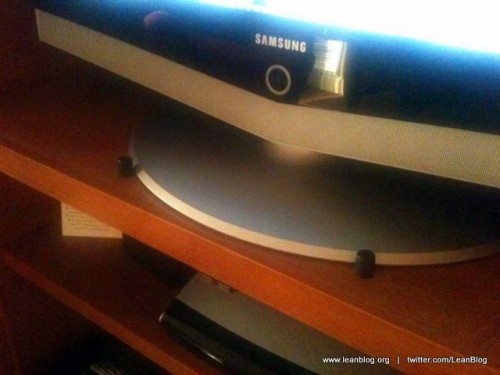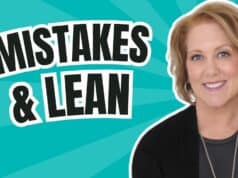Error proofing (aka “poka yoke” or mistake proofing) is such a powerful Lean method. Some people, unfortunately, think that Lean is only about speed or efficiency or cost. Going back to Toyota, the two pillars of TPS are Just in Time AND “Jidoka” (as shown in this diagram from the excellent Gemba Panta Rei blog).
Jidoka is a key quality methodology, as described on the Toyota website.
I recently stayed at a hotel where I saw a great example of “poka yoke,” or error proofing, in practice.
Many hotel rooms now have LCD TVs in them. The old heavy tube TVs weren't likely to be pulled forward and off of a cabinet or table. But the LCDs might be.
The hotel didn't hang an ugly sign saying “Caution: Don't pull TV off of table!”. A sign like that, if it existed, would be a great addition to my collection of “Be More Careful” signs.
Here is what the hotel did — it was subtle and I didn't notice it at first:
See the two little nubs (or whatever you call them) in front of the silver stand? This effectively prevents you from sliding the TV too far forward without having to bolt down the whole TV.
Simple and effective. Like many error proofing devices, it seems so obvious in hindsight.
Have you been able to install any error proofing devices or modifications to your own equipment or workspaces in your job?
Please scroll down (or click) to post a comment. Connect with me on LinkedIn.
Let’s work together to build a culture of continuous improvement and psychological safety. If you're a leader looking to create lasting change—not just projects—I help organizations:
- Engage people at all levels in sustainable improvement
- Shift from fear of mistakes to learning from them
- Apply Lean thinking in practical, people-centered ways
Interested in coaching or a keynote talk? Let’s start a conversation.










![When Was the Last Time a Leader Around You Admitted They Were Wrong? [Poll]](https://www.leanblog.org/wp-content/uploads/2025/07/Lean-Blog-Post-Cover-Image-2025-07-01T212509.843-100x75.jpg)
Well done! And what was the service like?
If they had used lean, you might have been answered quickly, but not given what you wanted.
The staff member might have responded to you (and furtively looked under the desk at her standardized work sheets). Or perhaps he/she could write the standardized work sheets later. Well, if the worker sets them and targets they are more relevant. Right?
For me these obsessions with the tools, 5s, Poke Yoke, Kaizen epitomize what is wrong with lean. The obsession over the tools whilst missing the big picture.
Oh great, here come the so-called “systems thinkers” invading my blog. How about you read actually read another post or two and see how “tool obsessed” I am. Tools and examples like this illustrate the thinking, but systems thinkers have a blind spot about seeing how tools and philosophy can work together.
An example like this illustrates the thinking that we don’t blame people for avoidable errors and mistakes. We design systems that make errors impossible or more difficult. I presume you would criticize life-saving error proofing devices in health care as mere tools??
I agree with Seddon that a blind application of tools is bad. I call that “L.A.M.E.” I’ve called out those in the UK who had foolish-looking 5S efforts:
https://www.leanblog.org/2007/02/bad-lean5s-hits-uk-media/
One other comment, DC — I haven’t worked with hotels, I have worked with hospitals. I can’t think of a single instance where something like what you described occurred. Standardized work in healthcare, from what I’ve taught and seen put in place, is not as you comically describe. What you describe would be bad, of course.
I’m tired of the broad criticism of what the John Seddon camp thinks is “lean.”
There are two camps here – those who say tools are useless and those who say tools are helpful WITH the right thinking and culture. It’s turned into some holy war with John Seddon calling people “Toolheads” and calling Lean a “wicked disease.” Over generalize much? That’s not helpful.
The hospitality industry seems to be real laggards in all forms of continuous improvement. As a very-frequent-flyer, I really wish they would get to work. There seems to be an attempt by most hospitals to solve their problems either with new technology, a refreshed lobby, or some effort to get employees to “try harder.”
This is only one hotel, and a small one, within a very large chain. But the general manager did a great job, just trying to fix problems that employees had in trying to serve guests. You can see the story here: http://www.leanlearningcenter.com/aboutus/our_experience__marriott.cfm
I think the first thing hotels should do is really check their value proposition, and get straight about who the customer is. Too often, it appears that policy is the customer, and not the guest.
Jamie F
I never noticed your Be Careful site until today. Great stuff. You might like this sign from ODDLY SPECIFIC:
.-= Brian Buck ´s last blog ..More Committed Than Ever =-.
I like the simple example of the error proofing. They didn’t over complicate the fix. They kept it low cost but effective. “Creativity over Capital.”
A criticism is not an attack.
DC – what are you talking about, exactly?
Yes, I’ve accused John Seddon (and some of his followers) of “attacking” people and he’s made it quite personal with me before.
There’s constructive criticism, then there’s criticism, then there are “attacks.” It’s all in the tone and the language. Seddon is an attack dog, pure and simple. That wasn’t very constructive of me, I realize, but I’ve quit trying to be constructive with the systems thinking crowd (meaning the John Seddon crowd, not the Deming fans or the Peter Senge folks, to be clear).
Seems to me that you are unable to meet his criticisms because you appear not to be able to understand what he is saying. Ignoring his arguments is not likely to solve the problem. Perhaps Seddon criticizes because he is frustrated by the Lean movement?
DC – I agree with much of what Seddon says – for example, command and control is bad, we should eliminate causes of rework instead of doing the rework more efficiently (what he calls “failure demand”), etc.
Where he loses me are his blanket statements such as “lean is a wicked disease” and that “lean does not work in services.” Those are exaggerations that I can only assume are calculated and self-serving, especially when he used to wrap himself in the “lean for service” banner up until 2008.
I disagree some aspects of Seddon’s approach (and especially his attitude). That doesn’t mean I don’t understand it.
If I don’t understand, then John Seddon isn’t that good of an educator, I guess. Being called “toolhead” and other personal insults have shut off my brain, apparently. Does John really think that people are in a state to learn after being personally insulted. And no, I don’t confuse his criticism ideas with personal attacks.